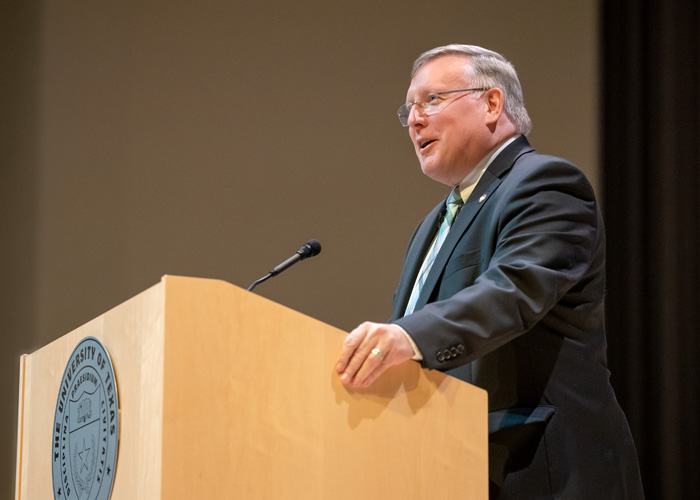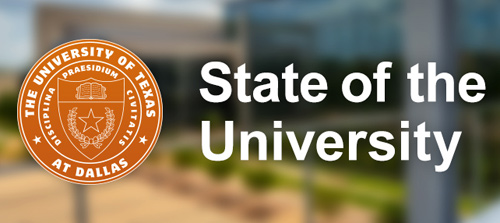In his annual State of the University presentation, UT Dallas President Richard C. Benson charted a path for an institution that has established itself as a first-tier, accelerated-growth university with an ambitious five-year strategic plan.

President Richard C. Benson discussed recent achievements and goals for UT Dallas during his annual State of the University presentation on Oct. 22.
Benson’s speech rounded up a sequence of recent achievements — including qualification for the National Research University Fund — and set forth a new set of targets and intentions for UT Dallas.
“The Chronicle of Higher Education noted that we were the fourth-fastest-growing university in the country. Needless to say, we’re the fastest growing in Texas,” he said of the listing of doctoral-awarding public institutions. “Again, it really shows how rapidly our reputation is starting to propagate out there.”
One focus of the presentation was the recently completed Strategic Plan, which breaks down the University’s goals into nine sections, covering themes such as attracting talent, engaging globally and advancing research.
“We said that we were going to become the MIT of the Southwest, so we’d better start competing with the MIT of the Northeast,” Benson said.
Another theme of the Strategic Plan is becoming an economic engine for the region, a goal that dates to the origins of UT Dallas as the Southwest Center for Advanced Studies.
“I think if our founders could come back, they would be thrilled — absolutely thrilled — at what has happened at UTD and what we have meant to the prosperity of this community,” said Benson, who holds the Eugene McDermott Distinguished University Chair of Leadership, named for one of those founders.
Bright Numbers
Among the most encouraging statistics covered in the presentation was the rising number of National Merit Scholars in each freshman class. The cohort for 2018 is 172 scholars; last year’s 157 was the third-highest in the nation among public universities.

Here are some key statistics that President Richard C. Benson highlighted during the State of the University:
Fall Enrollment: 28,757 (up 4% from fall 2017)
Freshman Class: Average SAT score of 1324 and 172 National Merit Scholars
Doctoral Graduates: 251 (up from 199 in 2016-17 academic year)
Research Dollars: $114.4 million (up from $113.2 million in fall 2017)
Endowment: $532 million (up from $483 million in fall 2017)
Read the rest of the highlights from the presentation here.
“This tells you how talented and how capable our students are in high school,” Benson said. “You’ve seen the growth in the freshman classes. It’s quite extraordinary.”
When discussing the majors declared by incoming students, Benson noted that two of the 10 most-popular programs are very new.
“For first-time-in-college freshmen, UT Dallas is very much a STEM-focused draw,” Benson said. “And two of the most in-demand majors are not even 10 years old here at UT Dallas: mechanical engineering and biomedical engineering. And Arts, Technology, and Emerging Communication as a school is only a couple of years old. So we have some really interesting and novel programs that are attracting students.”
Research Funding
One of the most significant achievements Benson noted was access to support from the National Research University Fund (NRUF), a state-supported source of research funding for high-achieving universities. This year’s distribution to UT Dallas was $7.5 million.
“Think of it almost as a startup package, but for the whole university,” Benson said. “Just as you might get a startup package to pick up some additional graduate students or to get an early jump on a new line of research — we will use these funds in that fashion.”
Among the benchmarks used for NRUF qualification is the number of doctorates awarded per year by a university. After a long period of hovering around the key number of 200, UT Dallas shot emphatically past that mark in 2017.
“All of a sudden it jumped to 250, the PhDs plus the audiology doctorates,” Benson said. “And we are making the sort of changes that will get us to 300.”
The downward trend in the number of graduate students applying to UT Dallas remains a concern, as was the case a year ago. Benson said attracting these applicants — especially international graduate students — is one of the University’s priorities.
“This is part of a national phenomenon that we’re working very hard to try to turn around,” Benson said. “I miss the intellectual capacity that comes with these bright students.”
Discussing the rise of research funding, Benson highlighted the steady uptick in federal money being awarded to the University.
“This is the hardest money to get. These are very competitive grants and contracts from the National Science Foundation, Department of Energy and so on,” Benson said. “For every opportunity out there, there are many good universities, many good researchers. It is gratifying that we are seeing some real success here, and we’re right on the threshold of about $40 million annually.”
Benson concluded by honoring the legacy of Margaret Milam McDermott, who passed away May 3. Her gifts to the University over a period of more than 20 years transformed the institution in every facet.
“Even though I’m only starting my third year, I cannot imagine what this university would be like without Margaret McDermott,” he said.